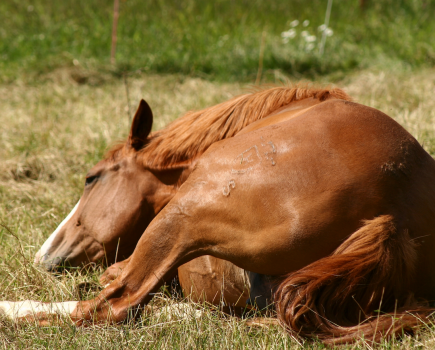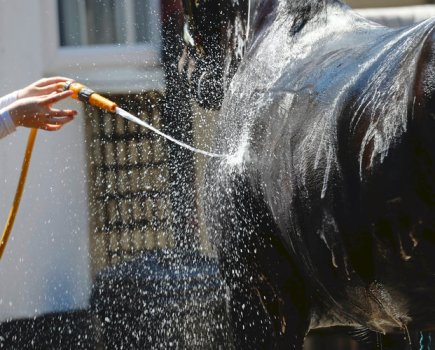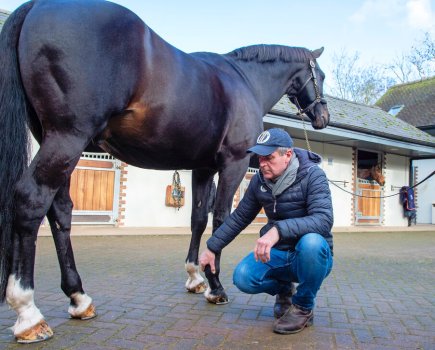Beth from XLVets Equine tells us all about a horse who refused to go on box rest.
When the vets’ WhatsApp group already has five messages by 7.30am, you know there’s a busy day in store for everyone.
Monday morning started with a mare who wouldn’t let her foal suckle and needed seeing again urgently.
Unfortunately everyone’s days were already full, so a major shuffle of visits ensued. Several extra routine calls were added to my day to free up one of my colleagues to see the foal, which resulted in a lot of driving in circles.
By mid morning, I’d given several vaccines, performed some heart checks for our equine dental technician (or tooth fairy as she’s fondly known) and had driven an awful lot!
My day was made even worse when a call to visit a horse with strangles was added to the end of my day.
As vets, we take biosecurity extremely seriously, so a visit to a yard with strangles means a lot of preparation to make sure we’re wearing suitable protective clothing and then a lot of packaging up everything we’ve used and washing down ourselves and all of our equipment.
This is definitely not a quick process so although it’s very much part of the job, it never brings us great joy to go to a yard with strangles, especially as it should always be done at the end of the day as an extra precaution.
Luckily, an ongoing patient who I saw at lunch time managed to brighten my day.
Meet Billy

One small but very deep wound over the front of his right hind fetlock.
I first met Billy about two months ago when his owner asked me to come and see him following an accident in the field.
He had panicked while she was removing his rug and jumped and ran through a post, rail and barbed wire fence.
Having cantered around the entire village he arrived back at his field looking rather alarmed and with several wounds.
Most of the wounds were rather large, but only superficial abrasions (grazes) between his hocks and stifles.
Unfortunately, there was one small but very deep wound over the front of his right hind fetlock.
When I put my finger into the wound, I could feel significant damage to the extensor tendon on the front of the leg.
Given the depth and location of the wound, it was important to make sure that the joint wasn’t affected.
Billy lives in a large field with four friends and doesn’t have access to a stable.
His owner advised me that he couldn’t be stabled or turned out in a small area as he wouldn’t tolerate it.
Given the severity of the wound, I felt a restriction in movement was essential and assured the owner that we’d be able to manage him in the clinic as we’d dealt with a large number of difficult horses. I was soon to be proven wrong!
Not an easy recovery
Billy came into the clinic where we tried to get a sample of the fluid in his fetlock joint, we weren’t able to aspirate any fluid out of the joint, which was a good sign as it indicates there isn’t too much inflammation.
We injected sterile water into the joint and none came out of the wound, confirming that the joint wasn’t affected.
Given the location of the wound and the amount of tension in the area, we decided to manage it open, i.e. without suturing. This means a long period of box rest and bandaging.
He spent the following week in a stable at our clinic. We were careful to make sure he always had company and he was given ACP daily to keep him relaxed.
Unfortunately, despite our best efforts, he was quickly proving his owner right and becoming very stressed in his box.
After 10 days, his wound was progressing well, although it still needed several months of box rest, so his owner organised a stable for him near home.
We transported him there and left him lightly sedated with a companion. Within 24 hours, he was so stressed, trying to jump out of his stable, refusing to eat and weaving almost constantly, that his owner decided she’d have to turn him out.
Waterproofing the wound
Managing a wound of this severity in a field is very unusual and the increased movement results in a much longer healing time.
It also means that the granulation tissues, which is the tissue that fills the hole before the skin grows across, has a tendency to overgrow and become ‘proud’ and has to be cut back.
As it was February when Billy first became injured, we were battling the elements too!
I’ve never had to make a bandage completely waterproof before, but it would’ve caused bandage rub had it become wet.
We were all concerned about the risks of the bandage rubbing and causing an additional injury due to all the walking he’d be doing in the field.
We decided to do a large two-layer bandage that I then covered from top to bottom with black tape.
Luckily this was successful and we continued with this type of bandage, changing it frequently for the next six weeks.
The wound progressed well but slowly, so all we could do was hope and wait.
At six weeks, the wound had stabilised and had less swelling and discharge.
After much discussion, we decided that the next inventive type of bandage to try would need to be one the owner could do.
She purchased a turnout boot and placed a light dressing underneath, which was changed every one to two days.
A run of bank holidays meant that this was the first time I’d seen Billy in about three weeks.
 When he walked across the field towards me, he looked very comfortable and his owner said that she hoped I’d be very pleased with his progress.
When he walked across the field towards me, he looked very comfortable and his owner said that she hoped I’d be very pleased with his progress.
After removing the bandage. I was thrilled to see that the skin had grown across really well and the wound was less than half the size it was when I’d last seen it.
Billy no longer needed a bandage and I left with the advice to spray the wound with silver spray twice a day until it had completely resolved.
As thrilled as I was, I didn’t envy them the task as his nervous disposition definitely included a fear of sprays!
He’s going to have another few months of holiday to allow the extensor tendon as much time as possible to settle down, but I’m looking forward to seeing him hacking across the downs by the end of the summer.








